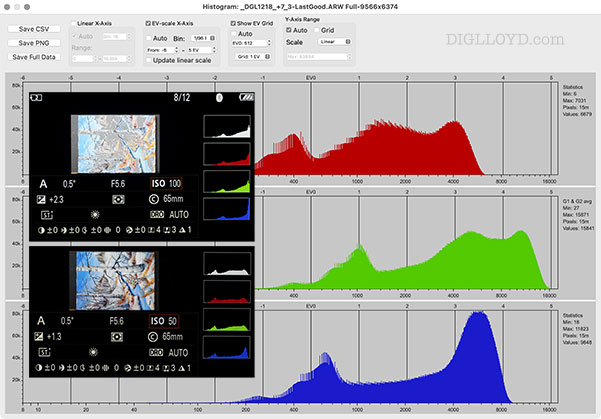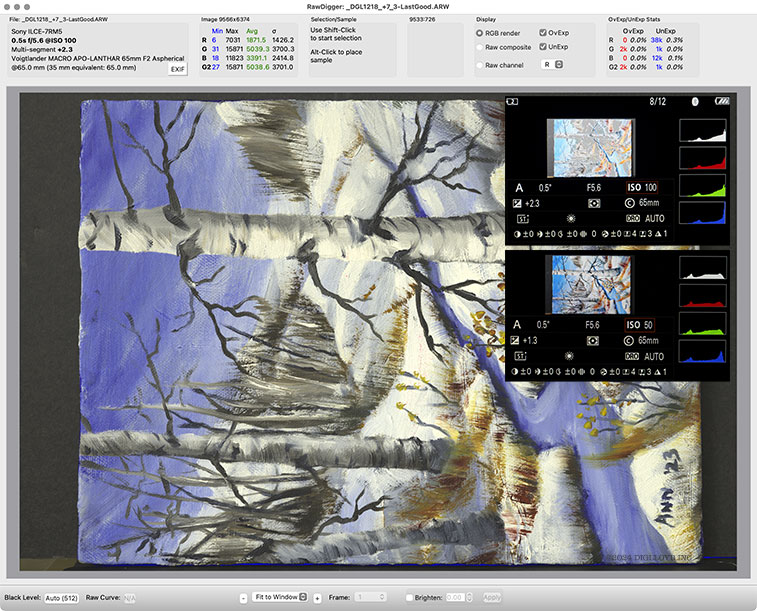ETTR, Camera Histograms vs RAW Histograms, ISO 100 vs ISO "Lo"
re: post processing and Adobe Camera Raw
re: ETTR
re: please fix this Sony

Referring to the following studies:
Sony A7R V: Metering, Dynamic Range, ETTR/ESTR, Camera Histograms (Color Card)
Sony A7R V: Metering, Dynamic Range, ETTR/ESTR, Camera Histograms (Birch Trees in Winter)
The whole idea of ETTR is confusing to most photographers.
I am grappling with how to explain it and all its foibles in some kind of how-to guide, but it’s not an easy thing, either conceptually, or in addressing how different cameras can behave differently (though the differences are generally minor).
What issue does ETTR address?
ETTR addresses underexposure, which means lower quality images. The idea is to increase exposure, often substantially.
Capture exposure should not be coupled to output brightness!
In all cameras today, JPEG output is coupled to capture brightness. That was unavoidable for film, a chemical medium that undergoes physical change when photons strike silver halide crystals.
The capture/output coupling is a ridiculous idea for digital. Most of the time, in results in discarding much of the potential of the sensor, leading to higher sensor noise and diminished dynamic range.
How does ETTR help?
The idea behind ETTR exposure is giving more exposure, then “pulling” the image during raw conversion. This is the decoupling of capture exposure from final-image brightness.
With more exposure, the resulting image is lower in noise and higher in real sharpness and dynamic range. It is analagous to the quality differences seen at ISO 400 vs ISO 100. Actually, it it is often literally that quality difference—see Birch Trees In Winter.
Does it always matter?
Cameras today are so good that you will almost always get very fine images just letting the camera do its thing. But you actually have a tool that if used optimally can do notably better, and that matters for professionals and those serious about making very high quality images.
In another sense it always matters: even the JPEG-only shooter suffers frequent exposure errors. That is, the camera often get image brightness wrong, if only by 1/3 or 2/3 stop. Any time you dial in positive exposure compensation, you are in effect using ETTR (negative exposure compensation is generally anti-ETTR, a forced error of dealing with the capture/output brightness coupling problem).
Poor tools for ETTR
There is no true RAW histogram in any camera today. Essentially, it would show what RawDigger shows, but in the camera. RawDigger is terrific, but it’s of no use away from the computer.
No camera vendor includes a RAW histogram.
But it gets stupider: some cameras are so stupidly engineered that they have no RGB histogram at all. Others are stupidly engineered by offering onlly sRGB color space.
Workaround for lack of true RAW histogram
RawDigger shows a true RAW histogram, but that’s on the computer, after the shot is taken and downloaded.
But what do you do in the field when taking images? This is one approach that might work for you. You face two key issues in applying more exposure:
- The image shown when played is a JPEG, baking in everything. It will be much too bright, scary bright as in unusable. This is not so, but it sure looks that way.
- The camera RGB histogram is really a camera JPEG histogram, based either on an embedded JPEG in the RAW or a sidecar JPEG generated along with the RAW. It is also scary-looking, since it is a histogram of that whacked-out JPEG.
ISO "Lo" eg ISO 50 instead of ISO 100
Sony A7R V: Perfect ETTR at ISO 50/100 using Zebra Display
Reader Comment: ETTR Technique Results in Too-Bright Images for Review
The exposures below are identical, both at 0.5 sec @ f/5.6. Camera at ISO 100 for one and ISO 50 for the other.
The actual RAW file as shown by RawDigger shows us that this was in fact the optimal exposure: nothing blown-out, with the green channel probing the maximum value. Perfect.
Meanwhile, the ISO 100 camera information tells us that we have created a useless blown-out image (false).
Whereas the ISO 50 camera information shows us something very close to the truth.
* Assuming no oddball hardware peculiarities and that is the case on the Sony A7R V.
Don’t miss the super useful tip on using a sub-base-ISO with ETTR.


























